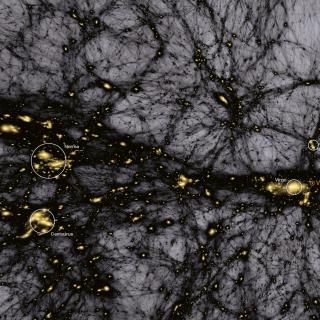Bibcode
Sinigaglia, Francesco; Kitaura, Francisco-Shu; Nagamine, Kentaro; Oku, Yuri
Referencia bibliográfica
The Astrophysical Journal
Fecha de publicación:
8
2024
Revista
Número de citas
9
Número de citas referidas
6
Descripción
We present the first measurement of the Lyα forest baryon acoustic oscillations (BAO) shift parameter from cosmological simulations. In particular, we generate a suite of 1000 accurate effective field-level bias-based Lyα forest simulations of volume at z = 2, both in real and redshift space, calibrated upon two fixed-and-paired cosmological hydrodynamic simulations. To measure the BAO, we stack the 3D power spectra of the 1000 different realizations, compute the average, and use a model accounting for a proper smooth-peak component decomposition of the power spectrum, to fit it via an efficient Markov Chain Monte Carlo scheme estimating the covariance matrices directly from the simulations. We report the BAO shift parameters to be and in real and redshift space, respectively. We also measure the bias b lya and the BAO broadening parameter Σnl, finding and in real space, and and in redshift space. Moreover, we measure the linear Kaiser factor from the isotropic redshift space fit. Overall, we find evidence for a negative shift of the BAO peak at the ∼2.2σ and ∼3.5σ levels in real and redshift space, respectively. This work sets new important theoretical constraints on the Lyα forest BAO scale and offers a potential solution to the tension emerging from previous observational analysis, in light of ongoing and upcoming Lyα forest spectroscopic surveys, such as DESI, the Prime Focus Spectrograph Survey, and WEAVE-QSO.
Proyectos relacionados

Cosmología con Trazadores de la Estructura a Gran Escala del Universo
El Fondo Cósmico de Microondas (FCM) contiene la información estadística de las semillas primigenias que han dado lugar a la formación de todas las estructuras en el Universo. Su contrapartida natural en el Universo local es la distribución de las galaxias que surgen como resultado del crecimiento gravitatorio de aquellas fluctuaciones de densidad
FRANCISCO SHU
KITAURA JOYANES